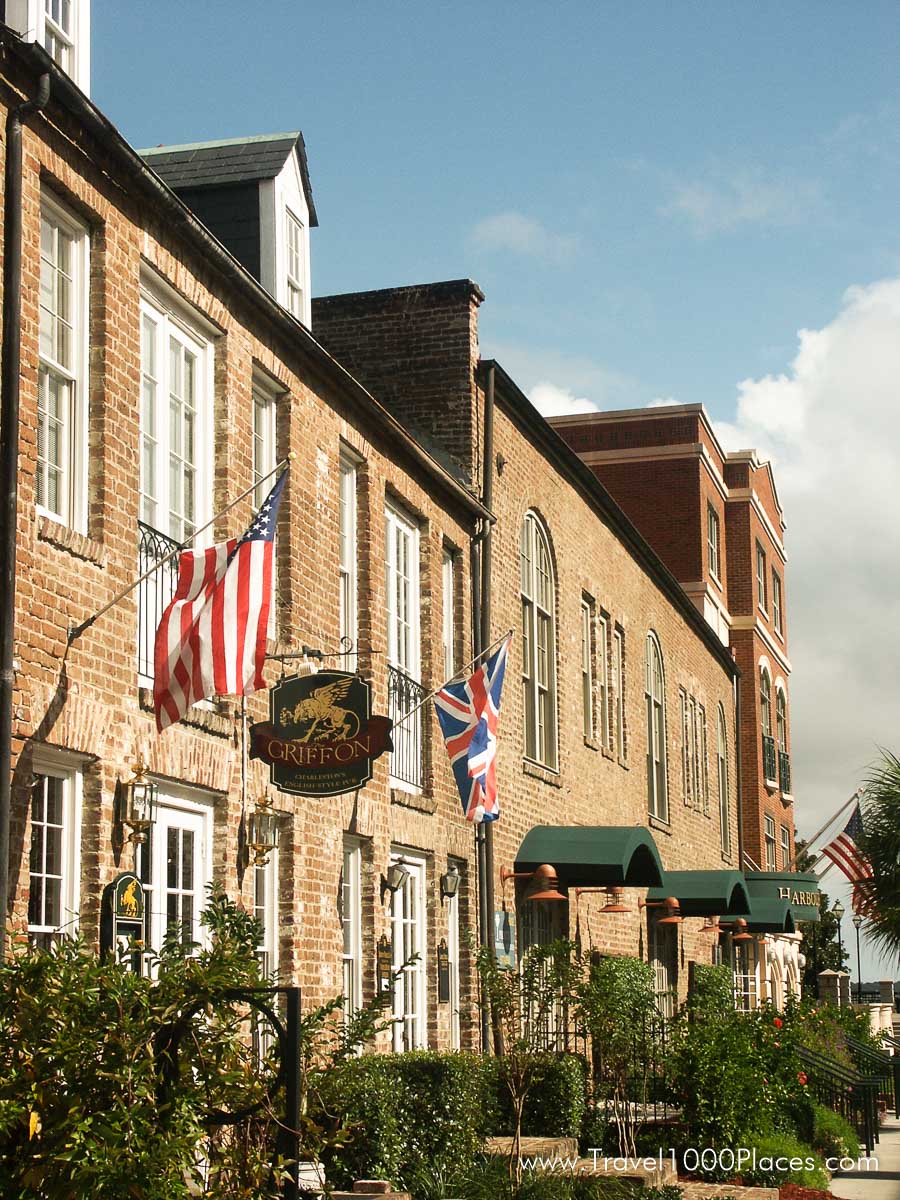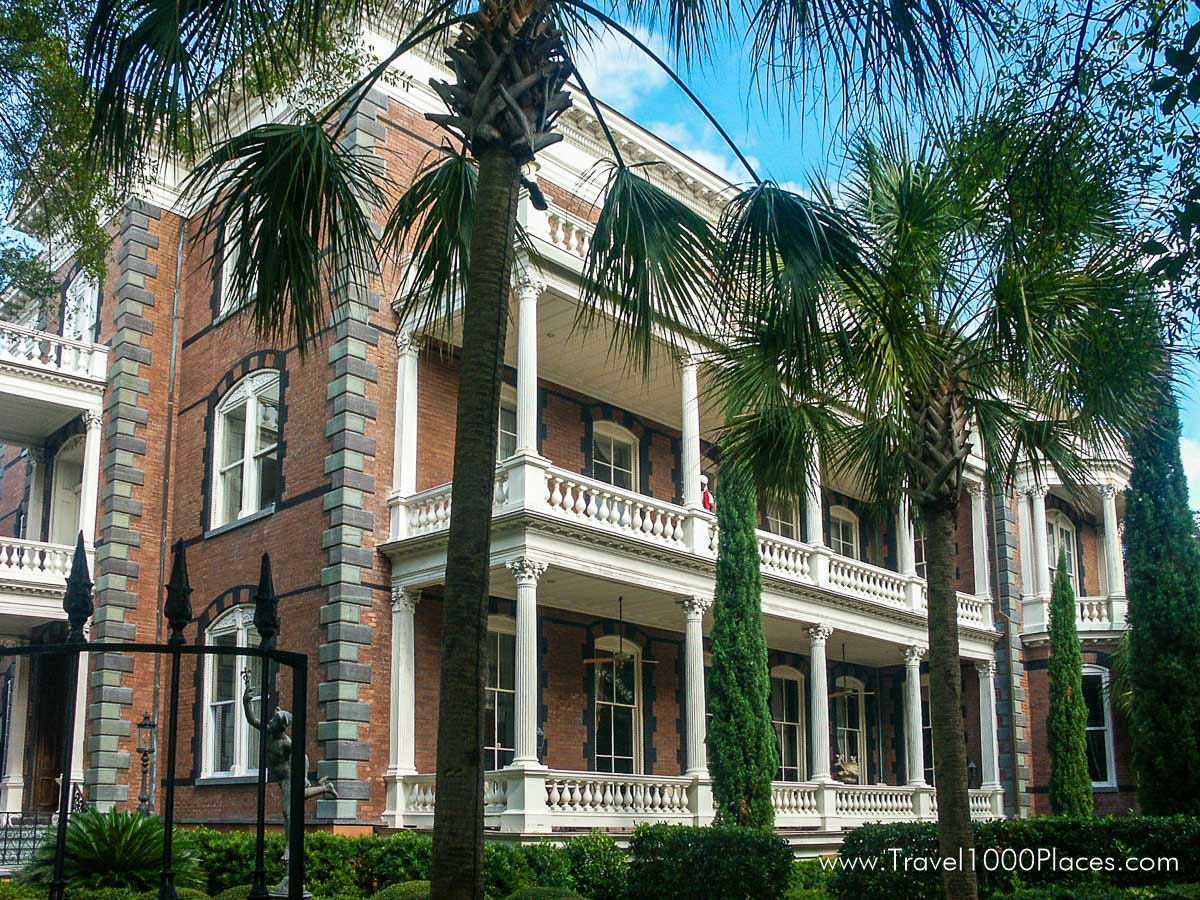
Quick Overview of Sights and Attractions
- The Battery
- Charles Town Landing
- Calhoun Mansion
- Drayton Hall and Edmondston-Alston House
- Heyward-Washington House
- Fort Sumter and Fort Moultrie
- Patriots Point Naval and Maritime Museum
- Mount Pleasant
- Magnolia Plantation
- Submarine Hunley
- Magnolia Cemetery
Islands near Charleston, South Carolina from north to south:
Isle of Palms, Folly Beach, Kiawah Island, Seabrook Island, Edisto Island, Hilton Head Island
Details of Sights and Attractions
The Battery
The Charleston Harbor, formed by the Cooper and Ashley Rivers, is a favorite spot for visitors to Charleston.
The rock sea wall along East Battery Street provides a walking path (promenade) for visitors to view historic Battery homes and mansions lining the waterfront and with exceptional views of White Point Gardens and Fort Sumter in the distance.
Charles Towne Landing State Historic Site
More than 35 years after it opened, Charles Towne Landing State Historic Site has been re-born, a seven-year, ongoing effort that has re-shaped the pivotal landmark’s ability to share the story of the birthplace of the first permanent European settlement in the Carolinas.
Once again, the Charleston experience begins at Charles Towne Landing, the spot where English settlers, recruited to extend the mercantile success of the British Empire in the Caribbean, sailed from Barbados in 1670 to establish a foothold on the secluded banks of what is now Old Towne Creek just off the Ashley River.
Years of planning followed by more than a year of construction has culminated with the Aug. 17, 2006, official opening of the 665-acre site’s new visitors center. It features 12 rooms of interactive exhibits that describe how settlers, slaves, traders and Native Americans came together to forge the beginnings of both one of Colonial America’s major cities and the plantation system of the American South.
The $19 million renovation project was made possible by strong support from local government and civic leaders, including lawmakers who helped ensure state funding would be available to secure Charles Towne Landing’s place as one of only a few preserved original English settlement sites in the United States, a list that includes Jamestown in Virginia and Maryland’s St. Mary’s City.
The park, which first opened in 1970 as part of South Carolina’s tricentennial celebration, also features a revamped interpretive and walking trail system, including a new marsh boardwalk; a reconstructed palisade wall of the size and construction and on the same location as the original; a new, working cannon embrasure guarding access by water; a garden with crops from that day; and the Animal Forest, a natural habitat zoo that’s home to species the settlers would have encountered, including pumas and bears.
Another highlight of the park is the Adventure, a full-size and functional replica of the kind of 17th-century sailing ship that traders used to help spark the port city of Charleston and European expansion in America.
Such ships plied the stormy waters between the Carolinas and the Caribbean, and the link between Charleston and Barbados is explored at the park by living history interpreters in special programs for schoolchildren and adult visitors alike.
The Barbados connection is integral to the story of Charles Towne Landing. The Lords Proprietor in London had paid for the settlers’ trip to the mainland with the intent of spreading to America the financial success of the sugar plantations on their Caribbean colony. A local group of Native Americans, the Kiawah, allied with the settlers and showed them how the small peninsula the Englishmen named Albemarle Point provided a natural defense against enemies, especially the Spanish, approaching by water.
Charles Towne Landing also is home to the Legare-Waring House, the former home of Ferdinanda Legare Waring, an accomplished horticulturist and dedicated preservationist. During her years there, Mrs. Waring planted an oak alle’ and extensive stands of camellias and azaleas and expanded the house of the overseer of Old Towne Plantation (it now serves as an elegant setting for weddings and other gatherings) to be her own. She later donated her home and the land to the state to preserve the historic site in perpetuity.
Driving Directions:
From I-26 E: Take Cosgrove Road exit 216A onto Hwy. 7 (Sam Rittenberg Blvd.) bear left onto Hwy. 171 (Old Town Rd.)
Follow signs for Charles Towne Landing. The park is on the left at a traffic light.
Daily 9am-5pm
Web: Charles Towne Landing | South Carolina Parks Official Site

Calhoun Mansion
George Walton Williams, a wealthy merchant and banker, built this Victorian Baronial Manor House following the Civil War (circa 1876).
The 24,000 square-foot mansion has 14-foot ceilings, ornate plaster and wood moldings, elaborate chandeliers, a stairwell that reaches to a 75-foot domed ceiling, as well as a ballroom with a coved glass skylight that is 45 feet high.
Used in the films, “Scarlett” and “North and South” and featured on A&E’s “American Castles.” Guided tours (about 45 minutes) and Behind-the-scenes tours (about two hours) are available.
Address: 16 Meeting Street, Charleston
Web: Calhoun Mansion
Drayton Hall
Construction of the Drayton Hall plantation house began in 1738 by John Drayton and its Georgian-Palladian architecture represents the oldest surviving example of its kind in the American South (no plumbing or electricity was ever used). Professional guides enlighten visitors about the dynamics affecting Drayton Hall over time and lead dedicated program discussions about African American history.
Address:
3380 Ashley River Road Charleston, South Carolina 29414 USA
Web: Drayton Hall Home – Drayton Hall
Edmondston-Alston House
The stately Edmondston-Alston House was built in 1825 on Charleston’s High Battery and is one of the city’s most splendid dwellings. A witness to many dramatic events in Charleston’s history, the Edmondston-Alston House is a classic example of the city’s changing and sophisticated taste in architecture and decorative arts.
The Edmondston-Alston House is a repository of family treasures, including Alston family silver, furniture, books and paintings that remain in place much as they have been for over a century and a half.
There is an exquisite collection of prints and other artifacts collected on Alston family trips abroad. Guided tours of the house give visitors an insight into the lifestyle of merchant Charles Edmondston, who first built the house in 1825, and Georgetown County rice planter Charles Alston, who later bought the house in 1838.
This privately-owned luxury bed and breakfast is nestled within the urban compound of Charleston’s historic 1825 Edmondston-Alston House, one of the first dwellings constructed along the High Battery facing Charleston Harbor.
Web: Visit the Historic Edmondston-Alston House | Charleston, South Carolina (edmondstonalston.org)
Heyward-Washington House
Built in 1772, The Heyward-Washington House was the town-home of Thomas Heyward, Jr., Revolutionary patriot and signer of the Declaration of Independence.
Built in 1772, The Heyward-Washington House was the townhome of Thomas Heyward, Jr., Revolutionary patriot and signer of the Declaration of Independence.
It was also George Washington’s temporary residence during his Southern Tour of 1791. Furnished with magnificent Charleston-made furniture, the collection includes the priceless Holmes Bookcase, considered to be the finest example of American-made furniture in existence today. The exquisite formal garden is comprised of plants available to Charlestonians during that period. Located in the original walled portion of the city, the neighborhood was used by Dubose Heyward as the setting for Porgy and Bess.
It was also George Washington’s temporary residence during his Southern Tour of 1791. Furnished with magnificent Charleston-made furniture, the collection includes the priceless Holmes Bookcase, considered to be the finest example of American-made furniture in existence today.
The exquisite formal garden is comprised of plants available to Charlestonians during that period. Located in the original walled portion of the city, the neighborhood was used by Dubose Heyward as the setting for Porgy and Bess.
Address:
87 Church Street
Web: Heyward-Washington House (U.S. National Park Service) (nps.gov)
Submarine Hunley
On August 8, 2000, the HUNLEY could be recovered from her water grave off the coast of Sullivan’s Island – – the conservation and reconstruction process could start. Today, the Hunley can be visited, please see further below. The Hunley Crew was buried on the Magnolia Cemetery in northern Charleston.
Horace Lawson Hunley
Mr. Hunley is the submarine inventor and financier of the first successful submarine ‘Hunley’. It could proof during the Civil War that it could actually sink an enemy ship.
Horace L. Hunley was born on Dezember 29th, 1823, in Sumner, Tennessee. In the beginning of the Civil War, he realized the importance of keeping the supply lines with Europe open and eventually met with James McClintock and Baxter Watson to bring his idea of a submarine to life. On Oktober 15, 1863, he died with his crew during a test run when the submarine got stuck on the bottom of Charleston Harbor.
On Februar 17th, 1864, the Hunley actually sank an enemy ship but disappeared shortly after.
Address
Warren Lasch Conservation Center
1250 Supply Street (at the old Charleston Navy Base)
North Charleston, SC 29405
Web: The Friends of The Hunley – The World’s First Successful Combat Submarine
Magnolia Cemetery
Magnolia Cemetery was established on the grounds of a former 19th century rice plantaion and has more than 35.000 graves. It reflects the history and society of Charleston and surroundings.
Visitors find more than 2,200 Civil War graves and also the crew of the HUNLEY, the first successful submarine which sunk in 1864, eventually found their last rest here on April 17th, 2004.
Web: Magnolia Cemetery, Charleston, S.C.

